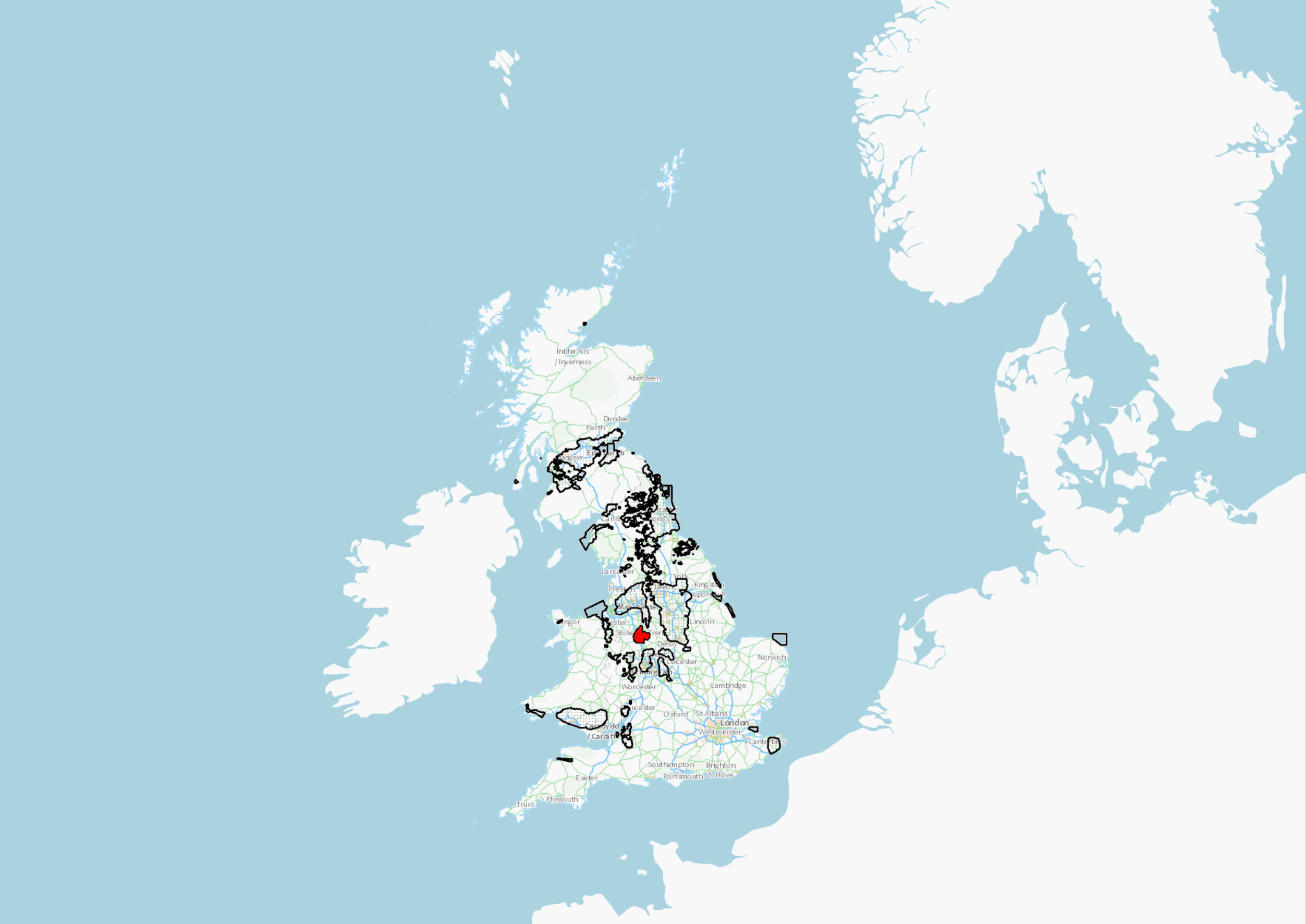Disaster planning: North Staffs
Map of Coal Mining Reporting Areas in the UK with North Staffs highlighted [1]
This article is based on a major premise, namely:—
- ... that in order to enable disaster planning to afford sufficient anticipatory design effort and product the necessary legislation and management is required.
and on the following minor premise:—
- ... that there is a link between sufficient anticipatory design effort and product and the necessary legislation and management.
Contents |
[edit] What do we know?
1.1 The site recognised in the original conception as a disaster area
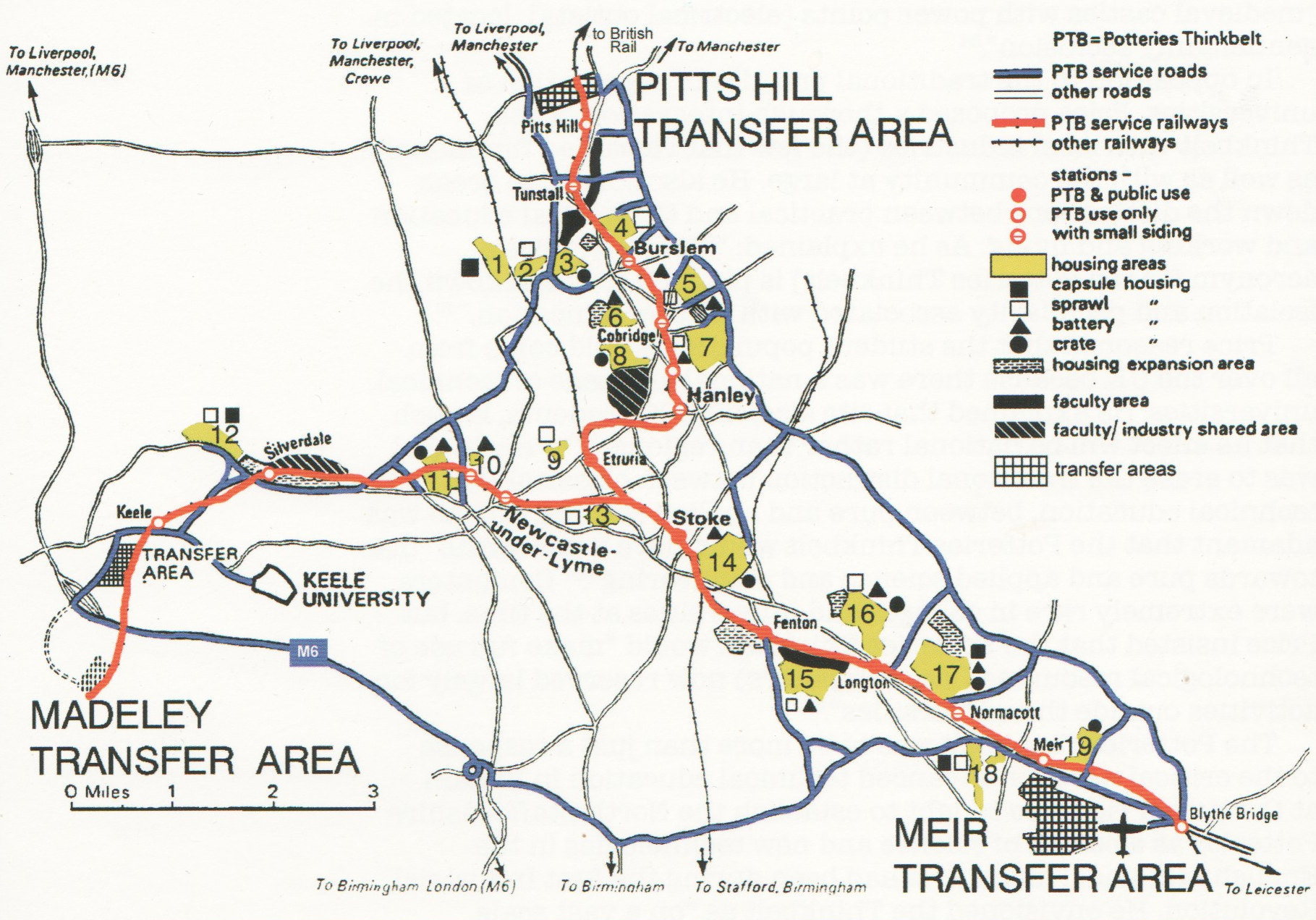 Site Plan of the Potteries Thinkbelt © CCA used with permission
Site Plan of the Potteries Thinkbelt © CCA used with permission
"First then, why this site? This part of North Staffordshire—including the Potteries and Newcastle-under-Lyne—is less well-to-do than the rest of the west Midlands. As regards buildings, it is a disaster area, largely unchanged and uncared for since its industrial expansion throughout the 19th century."
Price, C., 1966, Potteries Thinkbelt, New Society [2]
Thus Cedric Price knew:—
- ... that in terms of buildings the part of North Staffordshire including the Potteries and Newcastle-under-Lyne was a disaster area.
What do we know? (continuation)
1.2 The site collectively recognised as a disaster area
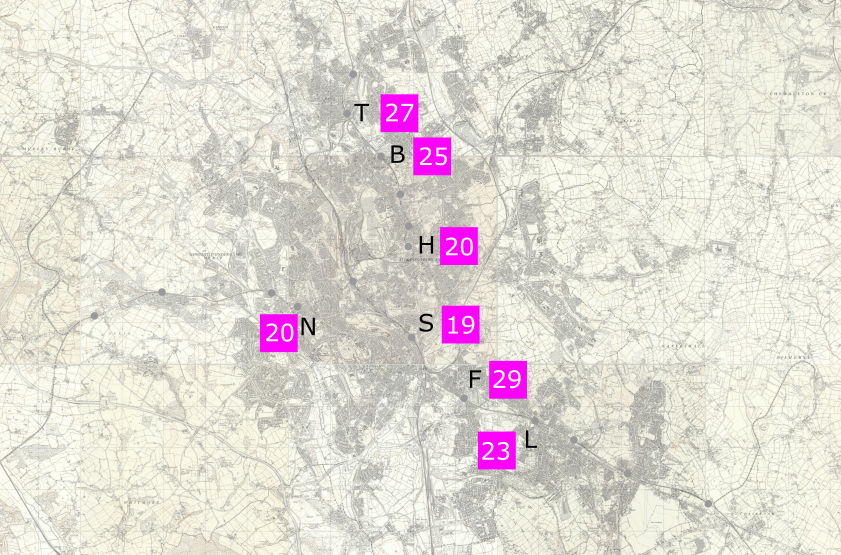 Map showing existing built-up areas c.1965 with numbers of photographs for each town - OS sheets out of copyright
Map showing existing built-up areas c.1965 with numbers of photographs for each town - OS sheets out of copyright
"As far as built physical environment goes (North Staffordshire—including the Potteries and Newcastle-under-Lyne) is a disaster area, largely unchanged and uncared for since the nineteenth century."
Price, 1966, 'Potteries Thinkbelt', p.484, Architectural Design [3]
Table 1 below provides links to photographic evidence that the site was a disaster area.
| Digitized Items For: Existing built-up areas in the early 1960s |
| T Tunstall [4] |
| B Burslem [5] |
| H Hanley (includes items from the 1970s) [6] |
| S Stoke (includes items from the 1970s) [7] |
| F Fenton [8] |
| L Longton [9] |
| N Newcastle [10] |
Thus collectively we know:—
- ... that in terms of buildings the part of North Staffordshire including the Potteries and Newcastle-under-Lyne was a disaster area.
[edit] Why do we care?
2.1 The necessary legislation and management is missing:—
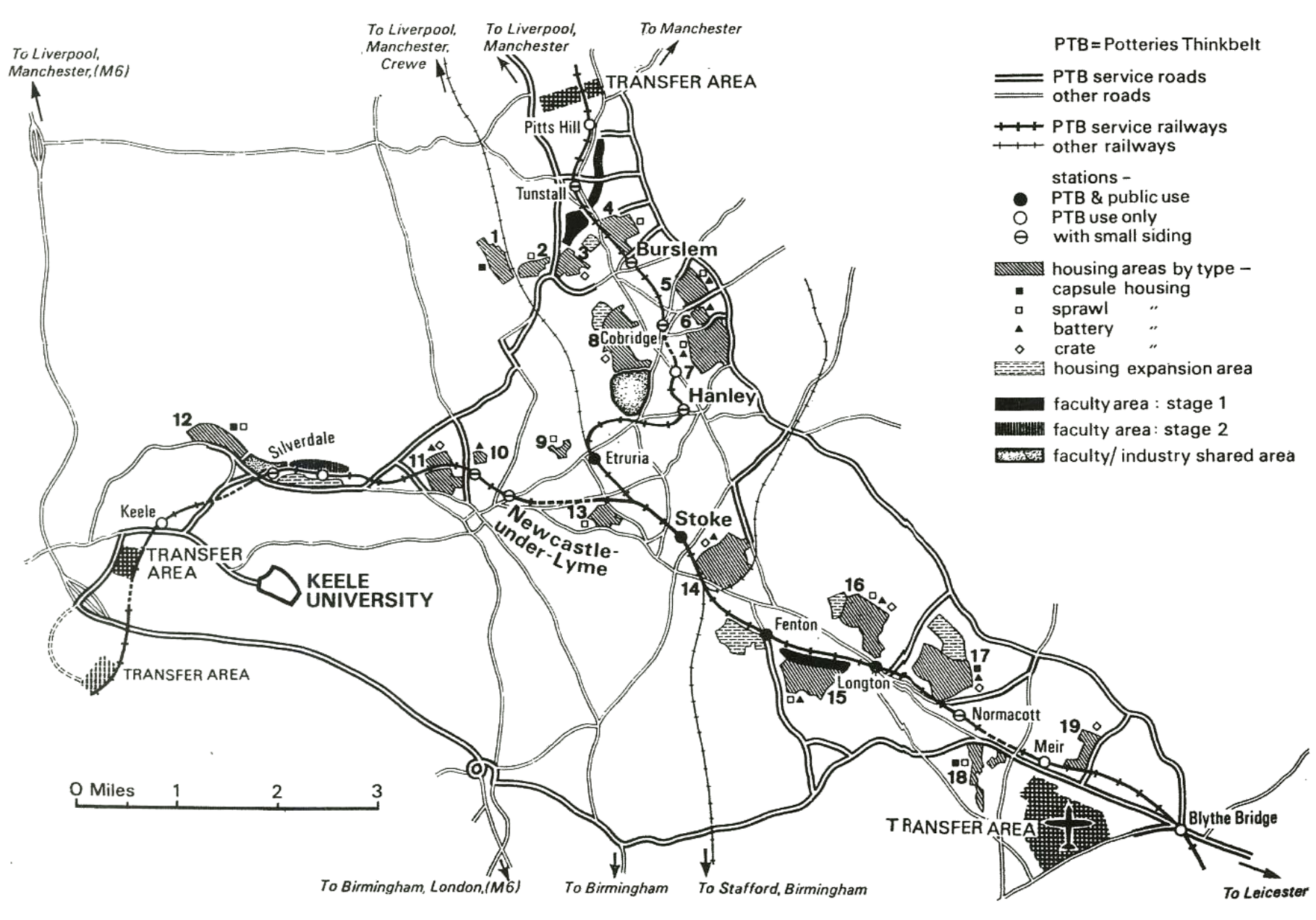 Map of the PTb from the report dated February 1966
Map of the PTb from the report dated February 1966
"The first ... point is the site in North Staffordshire. It doesn't matter where the site is ... but it was rough, it was dirty, rough industrial country. And it is still dirty and rough. A lot of the industry is gone but the land is still tired, dirty and tired."
Price, C., 2000 [11]
A report was submitted to the UK Government in February 1966 [12]. However, there was no official recognition of the site as a disaster area. Nor has there been since.
Thus we care in the particular case of North Staffordshire:—
- ... because the necessary legislation and management to enable disaster planning to afford sufficient anticipatory design effort and product is missing.
Why do we care? (continuation)
2.2 Sufficient anticipatory design effort and product has still not been afforded:—
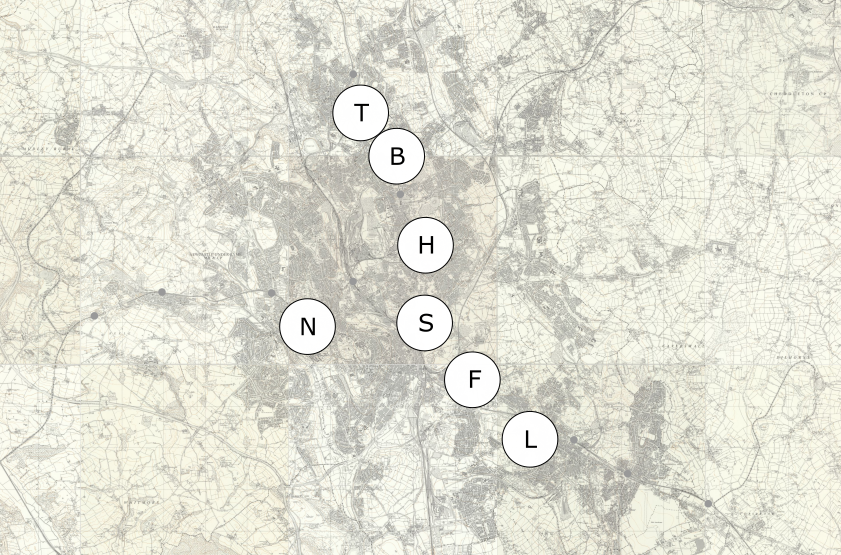 VENN DIAGRAMS with key in Table 2
VENN DIAGRAMS with key in Table 2
"There are still a lot of people in a desperate situation [...] because the environment is so poor. And in this hundred square miles, ... there are lots of pits, lots of old factories and lots of unused railway lines, as there were forty years ago, and they are still there today."
Price, ib. [13]
Table 2 below provides links to video evidence that the site is still a disaster area.
| Drone Footage For: Existing built up areas in the case study |
| T Tunstall |
| B Burslem |
| H Hanley |
| S Stoke |
| F Fenton |
| L Longton |
| N Newcastle |
Thus we still care:—
- … because sufficient anticipatory design effort and product has still not been afforded - i.e. in terms of buildings the site is still a disaster area.
[edit] What can we do?
3.1 Possible preservation as a 'World Heritage Site'
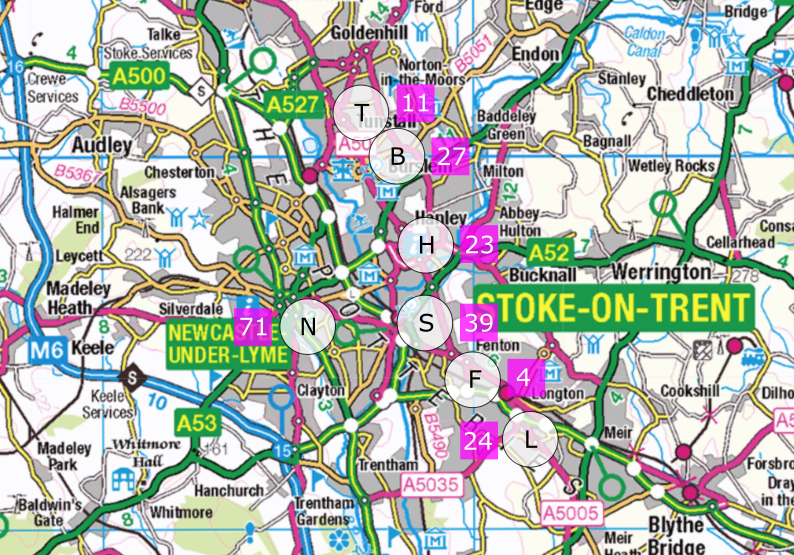 Map indicating the location of the proposed World Heritage Site
Map indicating the location of the proposed World Heritage Site
"It takes a number of years to go from shortlisting, to nomination, to designation, and so maybe we can consider having that debate as a city right now. Could the Potteries be a World Heritage Site?"
Dave Proudlove, 2019 [15]
Table 3 below provides links to photographs of 199 listed buildings in the area (numbers of items bracketed).
| Digitized Items For: Listed Buildings |
| T Tunstall (11) |
| B Burslem (27) |
| H Hanley (23) |
| S Stoke (39) |
| F Fenton (4) |
| L Longton (24) |
| N Newcastle (71) |
Thus we can:—
What can we do? (continuation)
3.2 Possible development giving due acknowledgement to the original conception
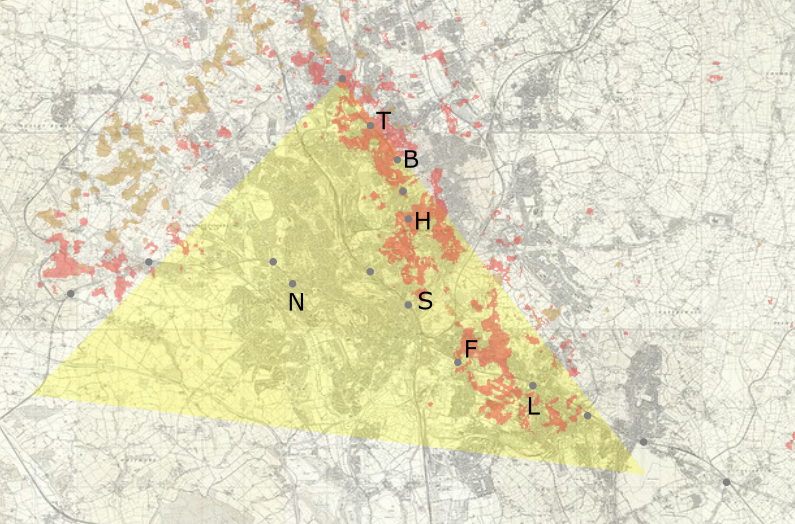 Map indicating location of 'Development High Risk Areas' in relation to towns
Map indicating location of 'Development High Risk Areas' in relation to towns
"(the Potteries Thinkbelt) marked an alternative to the conception of architecture as the construction of free standing buildings [...] It was not a 'building' ..."
Mathews, S., 2007 [16]
Alternatively, then:—
[edit] Notes
[1] The Coal Authority (2022) 'Interactive Map'
[2] Price, C. (1966) 'Potteries Thinkbelt', New Society, 2 June
[3] Price, C. (1966) 'Potteries Thinkbelt', Architectural Design, October
[4] Bould, S. (2020) 'Old pictures of Tunstall from the Bert Bentley Archive', Stoke Sentinel
[5] Bould, S. (2020) 'Bert Bentley Archive: These pictures show Burslem in the 1960s (Part2)', Stoke Sentinel
[6] Bould, S. (2020) 'The changing face of Hanley in the 1970s - amazing pictures from the James Morgan archive', Stoke Sentinel
[7] Bould, S. (2020) 'Photographer James Morgan - who travelled around Stoke-on-Trent on a bike - captures images from the city in the 70s', Stoke Sentinel
[8] Bould, S. (2020) 'Fascinating pictures from the Bert Bentley Archive showing the streets of Fenton (part 2)', Stoke Sentinel
[9] Bould, S. (2020) 'Old pictures of Longton from the Bert Bentley Archive (part one)', Stoke Sentinel
[10] Bould, S. (2020) '21 outstanding pictures from Newcastle in the 1960s taken by photographer Bert Bentley', Stoke Sentinel
[11] Price, C. (2000) quoted in Hardingham, S. and Rattenbury, K. (2007) 'Supercrit #1 Cedric Price: POTTERIES THINKBELT'
[12] Price, C. (1966) 'Potteries Think Belt: A plan for the establishment of a major advanced educational industry in North Staffordshire', in the Cedric Price fonds at the Canadian Centre for Architecture
[13] Price, C. [ib. 11]
[14] Fellows, N. (2022) 'Disaster planning: North Staffs', Archiblog on YouTube
[15] Proudlove, D. (2019) '"Could Potteries be a World Heritage site?"', Stoke Sentinel
[16] Mathews, S. (2007) 'From Agit-Prop to Free Space: The Architecture of Cedric Price'
[edit] Further reading
Aureli, P. V. (2011) 'Labor and Architecture: Revisiting Cedric Price's Potteries Thinkbelt', JSTOR
Cooke, R. (2014) 'The £1 houses and thriving potteries that are making Stoke boom again', The Guardian
Deakin, P. (2014) 'Coal Fields of North Staffordshire', advancebiker, YouTube
Fellows, N. (2014) 'Thinkbelt: From Original Conception to Possible Development', WordPress
Fellows, N. (2016) 'Dukeries Thinkbelt: A plan for an advanced educational industry in West Nottinghamshire', WordPress
Fellows, N. (2022) 'Potteries Thinkbelt: A plan for an advanced educational industry in North Staffordshire by Cedric Price', WordPress
Gibson, W., (1864) 'The Geology of the North Staffordshire Coalfields'
Goodwin, J. (2021) 'Stoke-on-Trent Is Sinking - Into the Thousands of Disused Mines Beneath It', HubPages
Gouk, A. and Corrigan, P, (2018) 'REVEALED: Stoke-on-Trent has the highest number of council homes with 'serious hazards' in the whole country', Stoke Sentinel
Landau, R. (1968) 'New Directions in British Architecture'
Merrick, J. (2014) 'Stoke-on-Trent becomes first British city to be classified as 'disaster resilient' by the United Nations', The Independent
Morris, C. (2013) 'The £1 home: More than 600 people apply to buy rundown houses in Stoke-on-Trent', Metro
Perera, D. (2017) 'What if Cedric Price's "Think Belt" was Built?', Academia
Ross, R. (2021) Letter to The Guardian in 'The potteries of Stoke need a recovery plan'
The Guardian (2021) 'The Guardian view on The Great Pottery Throw Down: eccentric and kind'
Walley, J. (2021) Letter to The Guardian in 'The potteries of Stoke need a recovery plan'
Wikipedia (2022) 'North Staffordshire Coalfield'
This article was written by Norman Fellows.
--Archiblog 10:38, 28 Oct 2022 (BST)
[edit] Related articles on Designing Buildings
Featured articles and news
RTPI leader to become new CIOB Chief Executive Officer
Dr Victoria Hills MRTPI, FICE to take over after Caroline Gumble’s departure.
Social and affordable housing, a long term plan for delivery
The “Delivering a Decade of Renewal for Social and Affordable Housing” strategy sets out future path.
A change to adoptive architecture
Effects of global weather warming on architectural detailing, material choice and human interaction.
The proposed publicly owned and backed subsidiary of Homes England, to facilitate new homes.
How big is the problem and what can we do to mitigate the effects?
Overheating guidance and tools for building designers
A number of cool guides to help with the heat.
The UK's Modern Industrial Strategy: A 10 year plan
Previous consultation criticism, current key elements and general support with some persisting reservations.
Building Safety Regulator reforms
New roles, new staff and a new fast track service pave the way for a single construction regulator.
Architectural Technologist CPDs and Communications
CIAT CPD… and how you can do it!
Cooling centres and cool spaces
Managing extreme heat in cities by directing the public to places for heat stress relief and water sources.
Winter gardens: A brief history and warm variations
Extending the season with glass in different forms and terms.
Restoring Great Yarmouth's Winter Gardens
Transforming one of the least sustainable constructions imaginable.
Construction Skills Mission Board launch sector drive
Newly formed government and industry collaboration set strategy for recruiting an additional 100,000 construction workers a year.
New Architects Code comes into effect in September 2025
ARB Architects Code of Conduct and Practice available with ongoing consultation regarding guidance.
Welsh Skills Body (Medr) launches ambitious plan
The new skills body brings together funding and regulation of tertiary education and research for the devolved nation.
Paul Gandy FCIOB announced as next CIOB President
Former Tilbury Douglas CEO takes helm.
UK Infrastructure: A 10 Year Strategy. In brief with reactions
With the National Infrastructure and Service Transformation Authority (NISTA).







